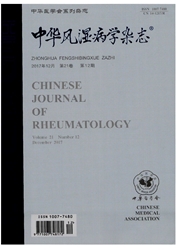

 中文摘要:
中文摘要:
目的探讨新型细胞因子白细胞介素(IL)-33在胶原诱导性关节炎(CIA)发病中的作用。方法建立DBA/1小鼠的CIA模型。以牛II型胶原(CII),完全福氏佐剂(CFA)免疫,从免疫后第21天开始每天注射IL-33或磷酸盐缓冲液(PBS)共5d。免疫后第28天取小鼠淋巴结细胞体外培养,培养上清的细胞因子浓度以酶联免疫吸附试验(ELISA)法检测或Luminex检测。同时检测血清中抗Ⅱ型胶原抗体和血清中的细胞因子浓度。鼠爪脱钙后行病理检查。采用两样本均数的t检验、r检验进行统计学处理。结果IL-33可使小鼠实验性的关节炎发病加重,致炎性细胞因子和抗Ⅱ型胶原抗体产生增多(P〈0.05),PBS组与IL-33组的IgG2a型Ⅱ型胶原抗体为[(1.24±0.33)mg/L和(1.96±0.16)mg/L,P〈0.05],而IgGl型抗Ⅱ型胶原抗体为[(1.1±0.4)mg/L和(1.7±0.4)mg/L,P〈0.05]。结论IL-33是炎性关节病中的重要致炎因子。这一IL-1家族新成员是潜在的类风湿关节炎(RA)治疗靶点。
 英文摘要:
英文摘要:
Objective To explore the role of a new cytokine interleukin (IL)-33 in collagen induced arthritis (CIA). Methods The murine model of CIA was employed. DBA/1 mice were immunized with C II/CFA and challenged with the same dose of CII in PBS on day 21. The mice were injected i.p daily with IL-33 or PBS for.5 days from day 21. Lymphonodes were removed on day 28 after primary immunization and cultured. The concentrations of all eytokines of the supernatants were determined by ELISA or an 20-plexmouse cyto-kine assay according to the manufacturer's instructions. Serum anti-C II antibody and mice paw histology were also assessed. Two indenpendent samples t test, chi-square test were used for statistical analysis. Results DBA/1 mice receiving 1L-33 injection exhibited an exacerbated CIA both in terms of clinical eyaluation and histological parameters. IL-17, IFN-γ, TNF-α, IL-5, IL-12, GM-CSF, MCP-1 and IP-10 productions were also elevated in IL-33 group (P〈0.05). Similarly, mice in the IL-33 injection group had higher levels of anti-collagen antibodies compared with those of the controls. The concentrations of C II - specific IgG2a were [(1.96±0.16) vs (1.24±0.33) mg/L] (P〈0.05), while IgG1 anti-C II antibodies were [ (1.1±0.4) vs (1.7±0.4) mg/L] (P〈0.05). Conclusion IL-33 is a critical pro-inflammatory cytokine for inflamm-atory joint disease. Thus this novel IL-1 superfamily member represents a novel therapeutic target for rheumatoid arthritis (RA).
 同期刊论文项目
同期刊论文项目
 同项目期刊论文
同项目期刊论文
 期刊信息
期刊信息
